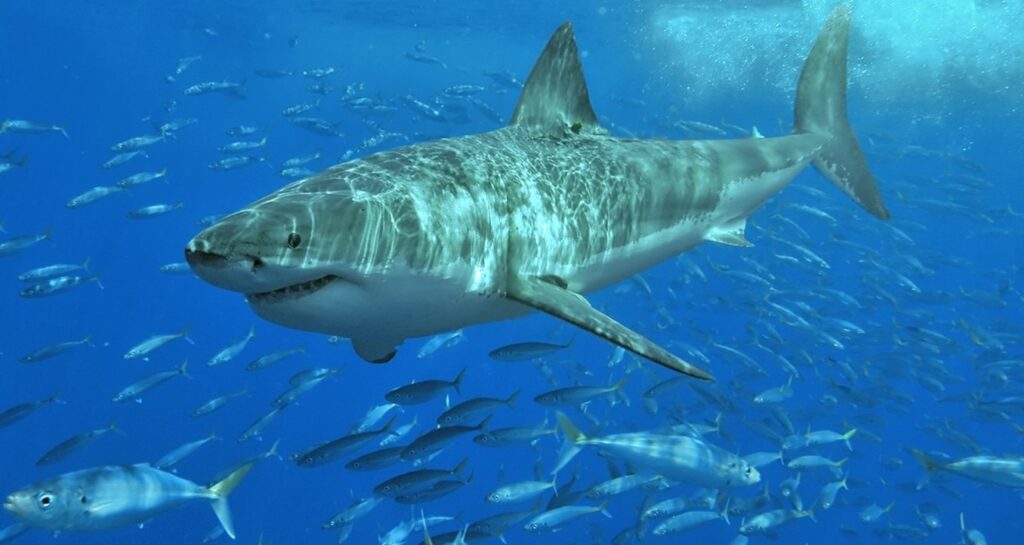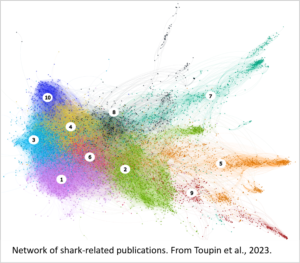What does research say about the shark species that navigate oceans all over the world? Is it critical to protect them? Does relevant scientific knowledge make its way to policymakers and journalists alike? In a study published on 13 September 2023 in Marine Policy, an internationally renowned journal dealing with marine affairs, we analyzed the attention given to scientific research articles about sharks. Specifically, we investigated the topics that are discussed the most in the scientific community, news media, policy documents, and Twitter (now X). Our main observations? 1) Only a few papers receive most of the attention. 2) Papers about fishing and the conservation of sharks attract the most attention in news media, policy documents, and on Twitter, while the papers that are cited the most in other research papers deal with immunology and physiology. 3) Among the four indicators (science, news media, policy, and Twitter), different papers receive the highest levels of attention.
As apex predators in the ocean worldwide, shark species play a critical role in maintaining healthy marine ecosystems. Shark species are endangered by issues like overfishing, bycatch, pollution, or climate change. Thus, shark conservation is an urgent matter related to ocean protection.
Science plays a crucial role in producing new knowledge that can
inform conservation policy and action.
However, concerns have been raised that public understanding of shark conservation may be biased by sensationalist news that often portrays sharks as dangerous creatures or focuses on specific issues, such as shark finning, that are likely to generate strong reactions from audiences. Thus, there is a need to understand better how scientific information reaches different audiences.
Research is a crucial component of the knowledge production process to inform action on conservation issues, notably policy and management decisions. Policymakers can be influenced either directly, for example, through scientific advice or meetings with scientists in expert committees, or indirectly through media and public pressure. Regarding sharks, concerns have been raised in the past that the sensationalist coverage they receive may lead to a biased or inaccurate perspective for conservation initiatives. Consequently, it is critical that all the relevant research about sharks reaches stakeholders, decision-makers, news media, and the public to provide a broader and more accurate perspective on shark conservation questions and policy. Our research demonstrates the diversity of shark-related research and its audiences, notably highlighting that particular topics may gain more attention, even though the manner of attention to a topic may differ between audiences. Therefore, we provide an overview of all the scientific literature about sharks, crucial outputs for researchers, communicators, resource managers, and stakeholders to ensure that relevant knowledge about shark conservation is considered in policies and practices.
In our study jointly published by a team of researchers from the Quantitative Science Studies (QSS) Lab and the multidisciplinary Environmental Information: Use and Influence (EIUI) research group in the Department of Information Science in the Faculty of Management at Dalhousie University, we investigated the level of attention that shark-related articles and topics receive in the scholarly literature, news media, policy documents, and Twitter (now X). Building on a dataset of 11,369 research papers published between 1991 and 2020 indexed in the Web of Science (WoS) databases of Clarivate Analytics, we gathered several indicators, such as the number of citations between papers (based on WoS data), as well as the number of mentions in news media, policy documents, and tweets from Altmetric.com Using citation mapping methods from bibliometrics, we first assessed clusters of research based on a tf-idf approach, which means we categorized them according to the most frequent specific terms in each cluster. We then calculated the attention to each cluster of research according to the four sets of indicators we collected, using z-scores values for comparison between clusters. We finally compared the distribution of attention between the indicators to examine whether similar papers attracted the most attention.
Our findings shed light on the diversity of shark-related research and its audiences. They show that very few papers receive most of the attention drawn to research and that the type and degree of attention varies between research articles and research topics. For example, research about conservation and fishing (cluster 3 in the network figure) attracts the most attention in the news media, policy documents, and tweets, whereas it is not the case in the scientific community (cluster 5 and 7, respectively about immunology and physiology receive the most attention). By highlighting the lack of correlation between the attention that a scientific article receives in the different spheres (or indicators), the study is a reminder that research impact is not a monolith concept and that using a single measure (such as citations) may not be adequate to fully capture and understand the impact that a particular research output may have. Moreover, understanding that research papers receive different levels of attention depending on the audiences is critical as it can support researchers who wish to communicate their findings outside of academia in framing their communication strategies accordingly.
Reference
Toupin, R., Melnick, K., Moharana, T., Curry, B., Gracey, C., Richards, N., MacDonald, B. H., & Mongeon, P. (2023). Measuring engagement with shark research in science, news, and social media, and policy: A bibliometric analysis. Marine Policy, 157, 105829. https://doi.org/10.1016/j.marpol.2023.105829
Author: Rémi Toupin
Image Credits: Great white shark. Photo by Terry Goss, copyright 2006. Taken at Isla Guadalupe, Mexico, August 2006. Wikipedia. https://commons.wikimedia.org/wiki/File:Whiteshark-TGoss5b.jpg. Network of shark-related publications is Figure 1 in Toupin et al. (2023).

